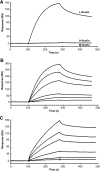Carbohydrate recognition properties of human ficolins: glycan array screening reveals the sialic acid binding specificity of M-ficolin
- PMID: 20032467
- PMCID: PMC2825457
- DOI: 10.1074/jbc.M109.065854
Carbohydrate recognition properties of human ficolins: glycan array screening reveals the sialic acid binding specificity of M-ficolin
Abstract
Ficolins are oligomeric innate immune recognition proteins consisting of a collagen-like region and a fibrinogen-like recognition domain that bind to pathogen- and apoptotic cell-associated molecular patterns. To investigate their carbohydrate binding specificities, serum-derived L-ficolin and recombinant H- and M-ficolins were fluorescently labeled, and their carbohydrate binding ability was analyzed by glycan array screening. L-ficolin preferentially recognized disulfated N-acetyllactosamine and tri- and tetrasaccharides containing terminal galactose or N-acetylglucosamine. Binding was sensitive to the position and orientation of the bond between N-acetyllactosamine and the adjacent carbohydrate. No significant binding of H-ficolin to any of the 377 glycans probed could be detected, providing further evidence for its poor lectin activity. M-ficolin bound preferentially to 9-O-acetylated 2-6-linked sialic acid derivatives and to various glycans containing sialic acid engaged in a 2-3 linkage. To further investigate the structural basis of sialic acid recognition by M-ficolin, point mutants were produced in which three residues of the fibrinogen domain were replaced by their counterparts in L-ficolin. Mutations G221F and A256V inhibited binding to the 9-O-acetylated sialic acid derivatives, whereas Y271F abolished interaction with all sialic acid-containing glycans. The crystal structure of the Y271F mutant fibrinogen domain was solved, showing that the mutation does not alter the structure of the ligand binding pocket. These analyses reveal novel ficolin ligands such as sulfated N-acetyllactosamine (L-ficolin) and gangliosides (M-ficolin) and provide precise insights into the sialic acid binding specificity of M-ficolin, emphasizing the essential role of Tyr(271) in this respect.
Figures






Similar articles
-
M-ficolin interacts with the long pentraxin PTX3: a novel case of cross-talk between soluble pattern-recognition molecules.J Immunol. 2011 May 15;186(10):5815-22. doi: 10.4049/jimmunol.1100180. Epub 2011 Apr 13. J Immunol. 2011. PMID: 21490156
-
Structural basis for innate immune sensing by M-ficolin and its control by a pH-dependent conformational switch.J Biol Chem. 2007 Dec 7;282(49):35814-20. doi: 10.1074/jbc.M705741200. Epub 2007 Sep 26. J Biol Chem. 2007. PMID: 17897951
-
Tethering of Ficolin-1 to cell surfaces through recognition of sialic acid by the fibrinogen-like domain.J Leukoc Biol. 2010 Jul;88(1):145-58. doi: 10.1189/jlb.1209802. Epub 2010 Apr 16. J Leukoc Biol. 2010. PMID: 20400674
-
Structural insights into the recognition properties of human ficolins.J Innate Immun. 2010;2(1):17-23. doi: 10.1159/000233475. Epub 2009 Aug 6. J Innate Immun. 2010. PMID: 20375619 Review.
-
Ficolins and the fibrinogen-like domain.Immunobiology. 1998 Aug;199(2):190-9. doi: 10.1016/S0171-2985(98)80026-0. Immunobiology. 1998. PMID: 9777405 Review.
Cited by
-
Studies of the pattern recognition molecule H-ficolin: specificity and purification.J Biol Chem. 2012 Mar 9;287(11):8071-81. doi: 10.1074/jbc.M111.301044. Epub 2012 Jan 11. J Biol Chem. 2012. PMID: 22238349 Free PMC article.
-
Association of ficolin-3 with severity and outcome of chronic heart failure.PLoS One. 2013 Apr 15;8(4):e60976. doi: 10.1371/journal.pone.0060976. Print 2013. PLoS One. 2013. PMID: 23596511 Free PMC article.
-
Comparison of printed glycan array, suspension array and ELISA in the detection of human anti-glycan antibodies.Glycoconj J. 2011 Dec;28(8-9):507-17. doi: 10.1007/s10719-011-9349-y. Epub 2011 Sep 23. Glycoconj J. 2011. PMID: 21948103 Free PMC article.
-
Recognition of microbial glycans by soluble human lectins.Curr Opin Struct Biol. 2017 Jun;44:168-178. doi: 10.1016/j.sbi.2017.04.002. Epub 2017 May 5. Curr Opin Struct Biol. 2017. PMID: 28482337 Free PMC article. Review.
-
Heparin-coated cardiopulmonary bypass circuits selectively deplete the pattern recognition molecule ficolin-2 of the lectin complement pathway in vivo.Clin Exp Immunol. 2015 Feb;179(2):294-9. doi: 10.1111/cei.12446. Clin Exp Immunol. 2015. PMID: 25174443 Free PMC article. Clinical Trial.
References
-
- Medzhitov R. (2007) Nature 449, 819–826 - PubMed
-
- Fearon D. T., Locksley R. M. (1996) Science 272, 50–53 - PubMed
-
- Fraser D. A., Tenner A. J. (2008) Curr. Drug Targets 9, 113–122 - PubMed
-
- Matsushita M., Fujita T. (2002) Immunobiology 205, 490–497 - PubMed
-
- Ohashi T., Erickson H. P. (2004) J. Biol. Chem. 279, 6534–6539 - PubMed
Publication types
MeSH terms
Substances
Associated data
- Actions
Grants and funding
LinkOut - more resources
Full Text Sources
Other Literature Sources
Molecular Biology Databases

